2015 MERCEDES-BENZ SLS AMG GT COUPE wheel
[x] Cancel search: wheelPage 56 of 290
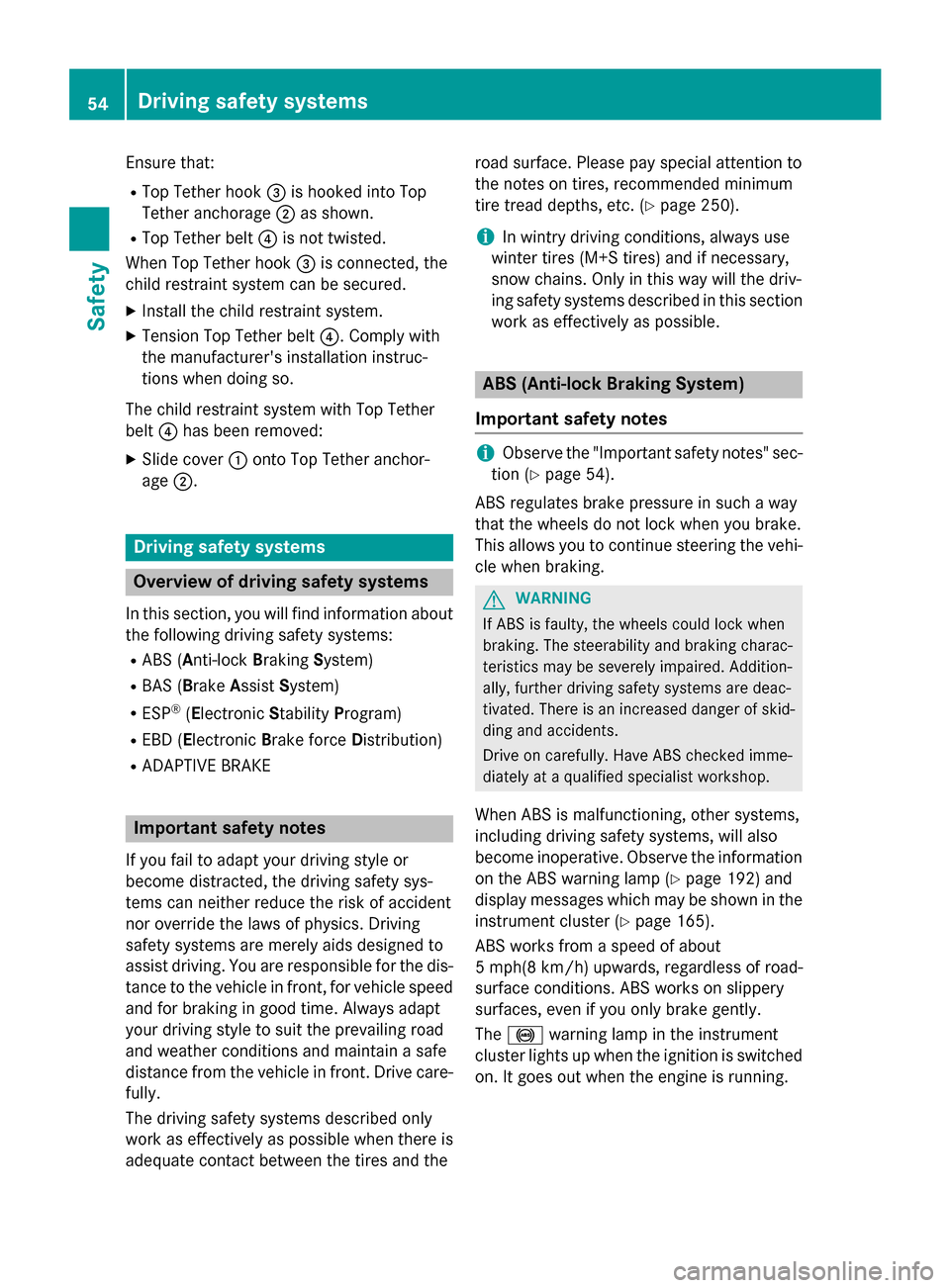
Ensure that:
R To pT ethe rh ook 0087is hooke dinto Top
Tethe ranchorage 0044as shown.
R To pT ethe rb elt 0085 is not twisted.
When To pTethe rh ook 0087is connected ,the
child restraint syste mcan be secured.
X Install the child restraint system.
X Tension To pTethe rb elt 0085.C om plyw ith
the manufacturer's installatio ninstruc-
tions when doing so.
Th ec hild restraint syste mwithT op Tether
belt 0085hasb eenr emoved:
X Slide cover 0043onto To pTethe ra nchor-
age 0044. Driving safety systems
Overvie
wofdrivingsafety systems
In thi ssection, yo uwillf in di nformation about
the following driving safety systems:
R ABS ( Anti-lock Braking System)
R BAS ( Brake Assist Sys tem)
R ESP ®
(Ele ctronic Stability Program)
R EBD ( Electronic Brake force Distribution)
R ADAPTIVE BRAKE Important safety notes
If yo ufailtoa dapt your driving style or
become distracted ,the driving safety sys-
tems can neithe rreduce the risk of accident
nor override the laws of physics .Driving
safety systems ar emerel yaidsd esig nedto
assist driving. Yo uareresponsibl efor the dis-
tance to the vehicl einfront, for vehicl espeed
and for braking in good time. Alway sadapt
your driving style to suit the prevailing road
and weather conditions and maintain asafe
distance fro mthe vehicl einfront. Drive care-
fully.
Th ed riving safety systems describe donly
work as effectivel yaspossibl ew hent here is
adequate contact between the tires and the roa
dsurface. Please pa yspecial attentio nto
the note sontires,recommended minimum
tir et rea ddepths, etc. (Y page 250).
i In wintry driving conditions
,alway suse
winter tires (M+S tires )and if necessary,
sno wchains .Onlyint hisw aywill the driv-
ing safety systems describe dinthiss ection
work as effectivel yaspossible. ABS (Anti-lock Braking System)
Important safety notes i
Observe the "Important safety notes" sec-
tio n(Ypage 54).
ABS regulate sbrake pressure in such away
tha tthe wheels do not lock when yo ubrake.
This allows yo utocontinue steering the vehi-
cle when braking. G
WARNING
If ABS is faulty, the wheels could lock when
braking .The steerability and braking charac-
teristics ma ybeseverel yimpaired. Addition-
ally ,fur the rdriving safety systems ar edeac-
tivated. There is an increase ddangerofs kid-
ding and accidents.
Drive on carefully. Have ABS checked imme-
diately at aquali fied specialis tworkshop.
When ABS is malfunctioning ,other systems,
including driving safety systems, will also
become inoperative. Observe the information on the ABS warning lamp (Y page 192)and
displa ymessage swhich ma ybeshown in the
instrument cluste r(Ypage 165).
ABS works fro maspeed of about
5m ph(8 km/h) upwards ,regardles sofroad-
surface conditions .ABS works on slippery
surfaces ,evenify ouonlybrake gently.
The 0025 warning lamp in the instrument
cluste rlight supw hent he ignition is switched
on. It goes ou twhent he engine is running. 54
Driving safet
ysystemsSafety
Page 57 of 290
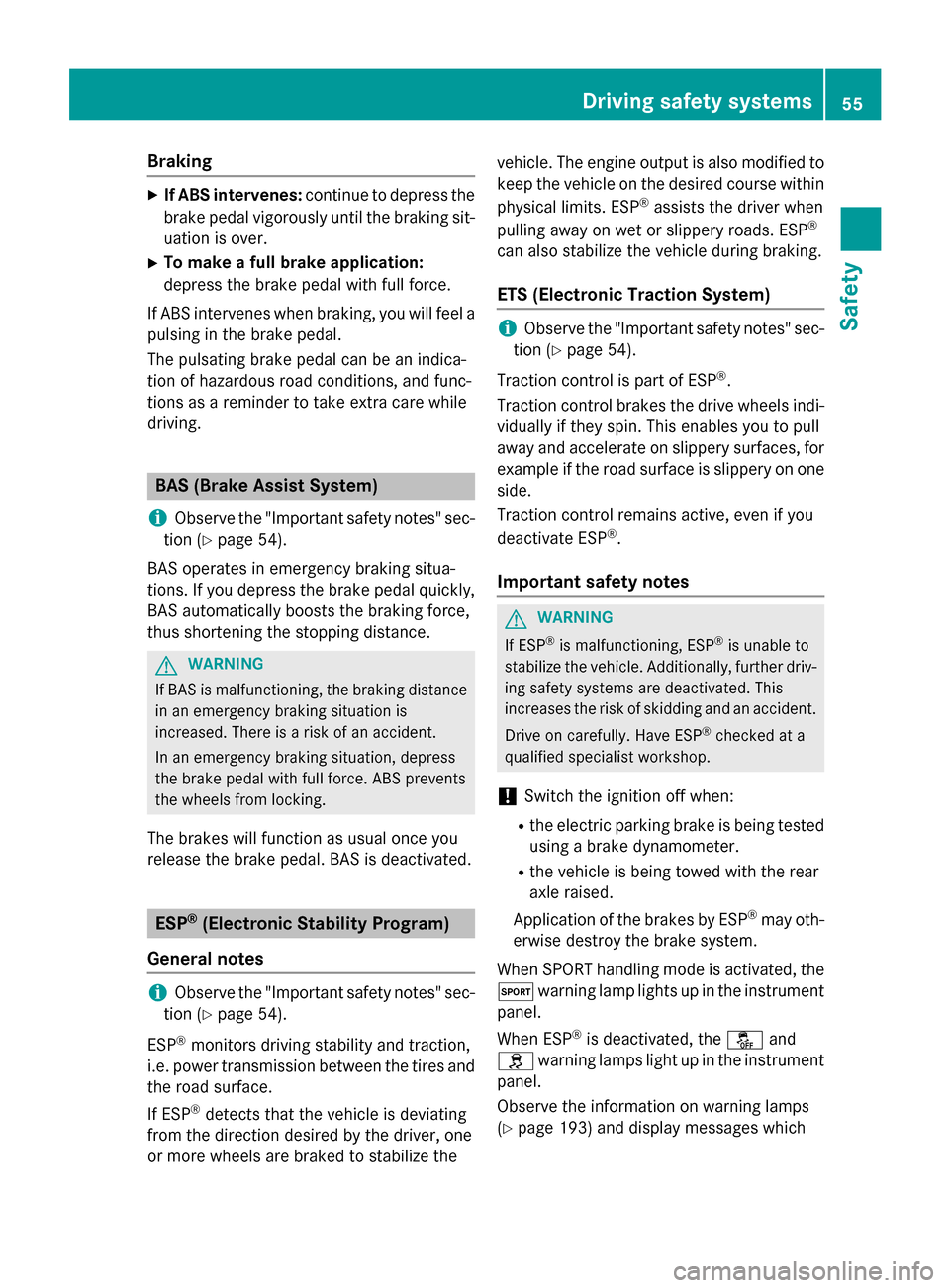
Braking
X
If ABS intervenes: continue to depress the
brake peda lvigorously unti lthe braking sit-
uatio niso ver.
X To make afullb rake application:
depress the brake peda lwithf ullf orce.
If ABS intervenes when braking ,you will fee la
pulsing in the brake pedal.
The pulsating brake peda lcan be an indica-
tio nofh azardou sroadc onditions, and func-
tions as areminder to take extra car ewhile
driving. BAS (Brak
eAssis tSystem)
i Observ
ethe "Important safety notes "sec-
tio n(Ypage 54).
BAS operates in emergency braking situa-
tions. If yo udepress the brake peda lquickly,
BAS automaticall yboosts the braking force,
thu sshortening the stopping distance. G
WARNING
If BAS is malfunctioning ,the braking distance
in an emergency braking situatio nis
increased .There is ariskofana ccident.
In an emergency braking situation, depress
the brake peda lwithf ullf orce. ABS prevents
the wheels from locking.
The brakes will functio nasusual once you
release the brake pedal. BAS is deactivated. ESP
®
(Electroni cStability Program)
General notes i
Observ
ethe "Important safety notes "sec-
tio n(Ypage 54).
ESP ®
monitors driving stability and traction,
i.e .power transmission between the tire sand
the roa dsurface.
If ESP ®
detects tha tthe vehicl eisdeviating
from the direction desired by the driver ,one
or more wheels ar ebraked to stabilize the vehicle. The engine outpu
tisa lsom odified to
kee pthe vehicl eonthe desired course within
physical limits .ESP ®
assists the driver when
pulling away on we torslipper yroads. ESP ®
can also stabilize the vehicl eduring braking.
ETS (Electroni cTraction System) i
Observ
ethe "Important safety notes "sec-
tio n(Ypage 54).
Tractio ncontro lispartofE SP®
.
Tractio ncontro lbrakes the drive wheels indi-
viduall yifthey spin. Thi senables yo utopull
away and accelerate on slippery surfaces, for
exampl eifthe roa dsurface is slippery on one
side.
Tractio ncontro lremains active, eve nifyou
deactivate ESP ®
.
Important safety notes G
WARNING
If ESP ®
is malfunctioning ,ESP ®
is unabl eto
stabilize the vehicle. Additionally, further driv- ing safety system sare deactivated. This
increases the ris kofskidding and an accident.
Driv eonc arefully. Hav eESP®
checked at a
qualified specialist workshop.
! Switch the ignition off when:
R the electri cparking brake is being tested
using abrake dynamometer.
R the vehicl eisbeing towed with the rear
axl eraised.
Application of the brakes by ESP ®
ma yoth-
erwis edestro ythe brake system.
Whe nSPOR Thandling mod eisactivated ,the
0074 warning lamp lights up in the instrument
panel.
Whe nESP®
is deactivated ,the 00BB and
0089 warning lamps light up in the instrument
panel.
Observ ethe informatio nonwarning lamps
(Y page 193 )and display messages which Driving safety systems
55Safety Z
Page 58 of 290
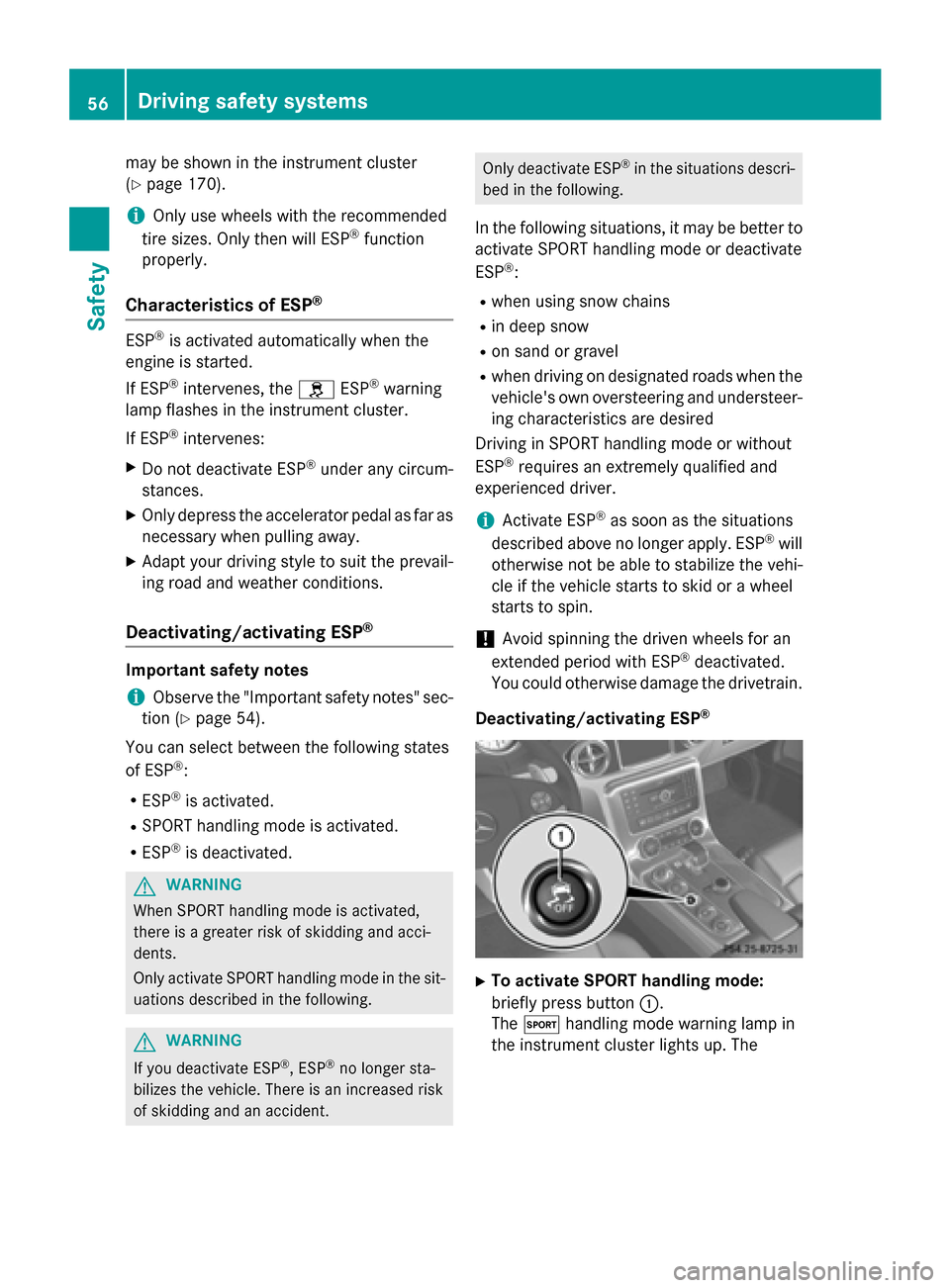
may be show
ninthe instrument cluster
(Y page1 70).
i Only use wheels with the recommended
tire sizes. Only then willE SP®
function
properly.
Characteristics of ESP ®ESP
®
is activated automatically when the
engine is started.
If ESP ®
intervenes, the 0089ESP®
warning
lamp flashes in the instrument cluster.
If ESP ®
intervenes:
X Do not deactivate ESP ®
under any circum-
stances.
X Only depress the accelerator peda lasfar as
necessary when pulling away.
X Adapt yourd riving style to suitt he prevail-
ing road and weather conditions.
Deactivating/activating ESP ®Important safety notes
i Observe the "Important safety notes" sec-
tion (Y page54).
You can select between the following states
of ESP ®
:
R ESP ®
is activated.
R SPORT handling mode is activated.
R ESP ®
is deactivated. G
WARNING
When SPORT handling mode is activated,
there is agreater risk of skidding and acci-
dents.
Only activate SPORT handling mode in the sit- uations described in the following. G
WARNING
If you deactivate ESP ®
,E SP ®
no longer sta-
bilizes the vehicle. There is an increase drisk
of skidding and an accident. Only deactivate ESP
®
in the situations descri-
bed in the following.
In the following situations, it may be better to activate SPORT handling mode or deactivate
ESP ®
:
R when using snow chains
R in deep snow
R on sand or gravel
R when driving on designated road swhen the
vehicle's own oversteering and understeer-
ing characteristics are desired
Driving in SPORT handling mode or without
ESP ®
requires an extremely qualified and
experienced driver.
i Activate ESP ®
as soon as the situations
described above no longer apply.E SP®
will
otherwise not be abletos tabilize the vehi-
cle if the vehicl estarts to skid or awheel
starts to spin.
! Avoid spinning the driven wheels for an
extended perio dwith ESP ®
deactivated.
You could otherwise damage the drivetrain.
Deactivating/activating ESP ® X
To activate SPORT handlin gmode:
briefl ypress button 0043.
The 0074 handling mode warning lamp in
the instrument cluster lights up. The 56
Driving safety systemsSafety
Page 59 of 290
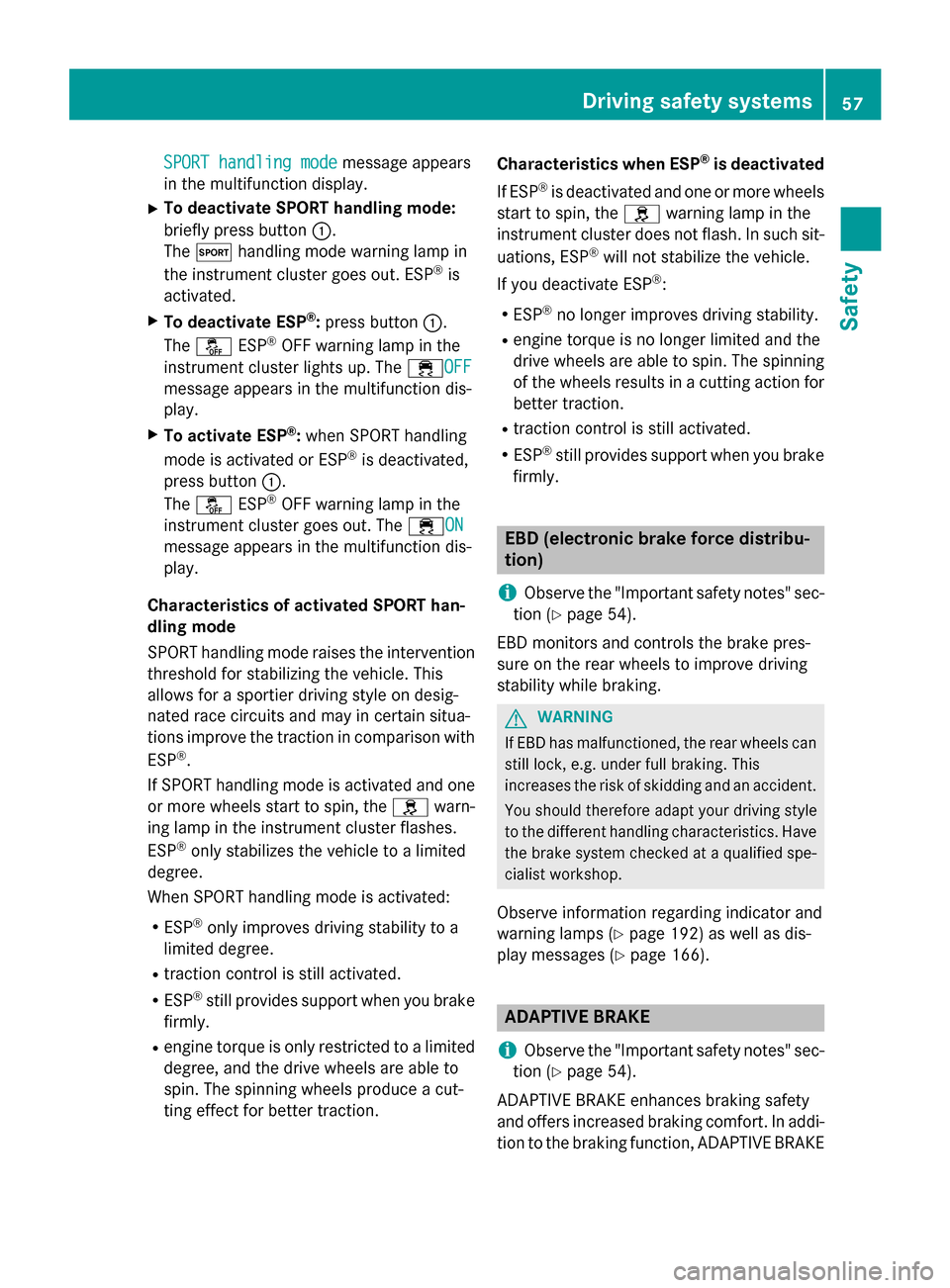
SPORT handling mode
SPORT handling mode
message appears
in the multifunction display.
X To deactivate SPORT handling mode:
briefly press button 0043.
The 0074 handling mode warning lamp in
the instrument cluster goes out. ESP ®
is
activated.
X To deactivate ESP ®
:press button 0043.
The 00BB ESP®
OFF warning lamp in the
instrument cluster lights up. The 00E5OFFOFF
message appears in the multifunction dis-
play.
X To activate ESP ®
:when SPORT handling
mode is activated or ESP ®
is deactivated,
press button 0043.
The 00BB ESP®
OFF warning lamp in the
instrument cluster goes out. The 00E5ONON
message appears in the multifunction dis-
play.
Characteristics of activated SPORT han-
dling mode
SPORT handling mode raises the intervention threshold for stabilizing the vehicle. This
allows for asportier driving style on desig-
nated race circuits and may in certain situa-
tions improve the traction in comparison with
ESP ®
.
If SPORT handling mode is activated and one or more wheels start to spin, the 0089warn-
ing lamp in the instrument cluster flashes.
ESP ®
only stabilizes the vehicle to alimited
degree.
When SPORT handling mode is activated:
R ESP ®
only improves driving stability to a
limited degree.
R traction control is still activated.
R ESP ®
still provides support when you brake
firmly.
R engine torque is only restricted to alimited
degree, and the drive wheels are able to
spin. The spinning wheels produce acut-
ting effect for better traction. Characteristics when ESP
®
is deactivated
If ESP ®
is deactivated and one or more wheels
start to spin, the 0089warning lamp in the
instrument cluster does not flash. In such sit-
uations, ESP ®
will not stabilize the vehicle.
If you deactivate ESP ®
:
R ESP ®
no longer improves driving stability.
R engine torque is no longer limited and the
drive wheels are able to spin. The spinning
of the wheels results in acutting action for
better traction.
R traction control is still activated.
R ESP ®
still provides support when you brake
firmly. EBD (electronic brake force distribu-
tion)
i Observe the "Important safety notes" sec-
tion (Y page 54).
EBD monitors and controls the brake pres-
sure on the rear wheels to improve driving
stability while braking. G
WARNING
If EBD has malfunctioned, the rear wheels can still lock, e.g. under full braking. This
increases the risk of skidding and an accident.
You should therefore adapty our driving style
to the different handling characteristics. Have the brake system checked at aqualified spe-
cialist workshop.
Observe information regarding indicator and
warning lamps (Y page 192) as well as dis-
play messages (Y page 166). ADAPTIVE BRAKE
i Observe the "Important safety notes" sec-
tion (Y page 54).
ADAPTIVE BRAKE enhances braking safety
and offers increased braking comfort.Ina ddi-
tion to the braking function, ADAPTIVE BRAKE Driving safety systems
57Safety Z
Page 72 of 290
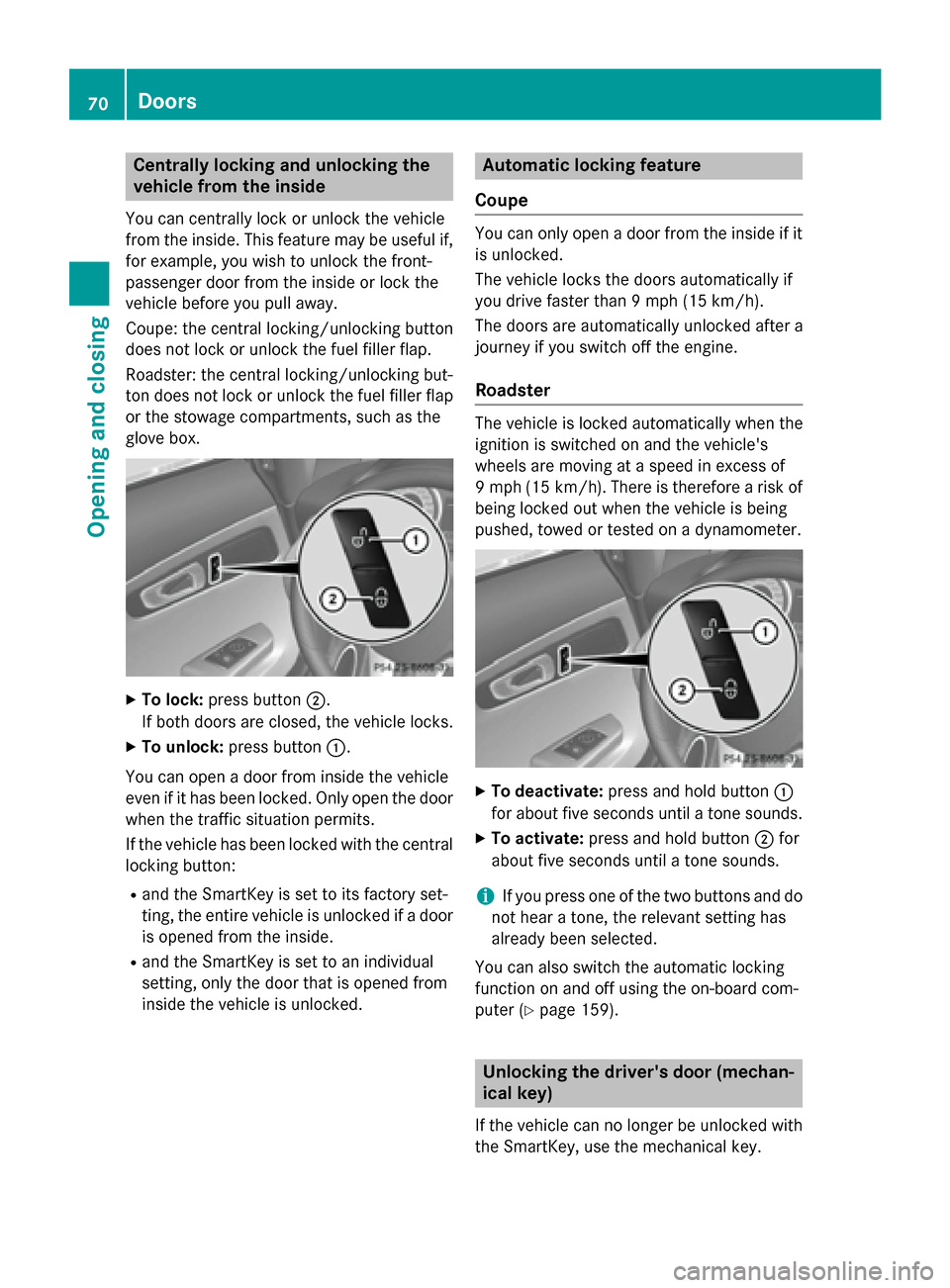
Centrally lockin
gand unlocking the
vehicle from th einside
You can centrally loc korunlock th evehicle
from th einside. This feature may be useful if,
for example ,you wish to unlock th efront-
passenger door from th einside or loc kthe
vehicle before you pull away.
Coupe: th ecentral locking/unlockin gbutton
does no tloc koru nlock th efuel fille rflap.
Roadster: th ecentral locking/unlockin gbut-
to nd oes no tloc koru nlock th efuel fille rflap
or th estowage compartments ,suc hast he
glov ebox. X
To lock: pressbutton 0044.
If bot hdoor sare closed, th evehicle locks.
X To unlock: pressbutton 0043.
You can open adoor from inside th evehicle
eve nifith as been locked. Only open th edoor
when th etraffic situatio npermits.
If th evehicle has been locke dwitht he central
lockin gbutton:
R and th eSmartKey is set to its factory set-
ting, th eentirev ehicle is unlocked if adoor
is opened from th einside.
R and th eSmartKey is set to an individual
setting, only th edoor that is opened from
inside th evehicle is unlocked. Automatic lockin
gfeature
Coupe You can only open
adoor from th einside if it
is unlocked.
The vehicle locks th edoor sautomaticall yif
you driv efaster than 9mph (15 km/h).
The door sare automaticall yunlocked after a
journey if you switch off th eengine.
Roadster The vehicle is locke
dautomaticall ywhen the
ignition is switched on and th evehicle's
wheels are moving at aspee dine xces sof
9m ph (15 km/h). Ther eistherefor eariskof
bein glocke dout when th evehicle is being
pushed, towed or tested on adynamometer. X
To deactivate: pressand hold button 0043
for about fiv eseconds until atones ounds.
X To activate: pressand hold button 0044for
about fiv eseconds until atones ounds.
i If you pres
sone of th etwo buttons and do
no th ear atone, ther elevan tsettin ghas
alread ybeen selected.
You can also switch th eautomatic locking
function on and off usin gthe on-board com-
puter (Y page 159). Unlocking th
edriver's door (mechan-
ical key)
If th evehicle can no longer be unlocked with
th eS martKey, use th emechanical key. 70
DoorsOpening and closing
Page 74 of 290
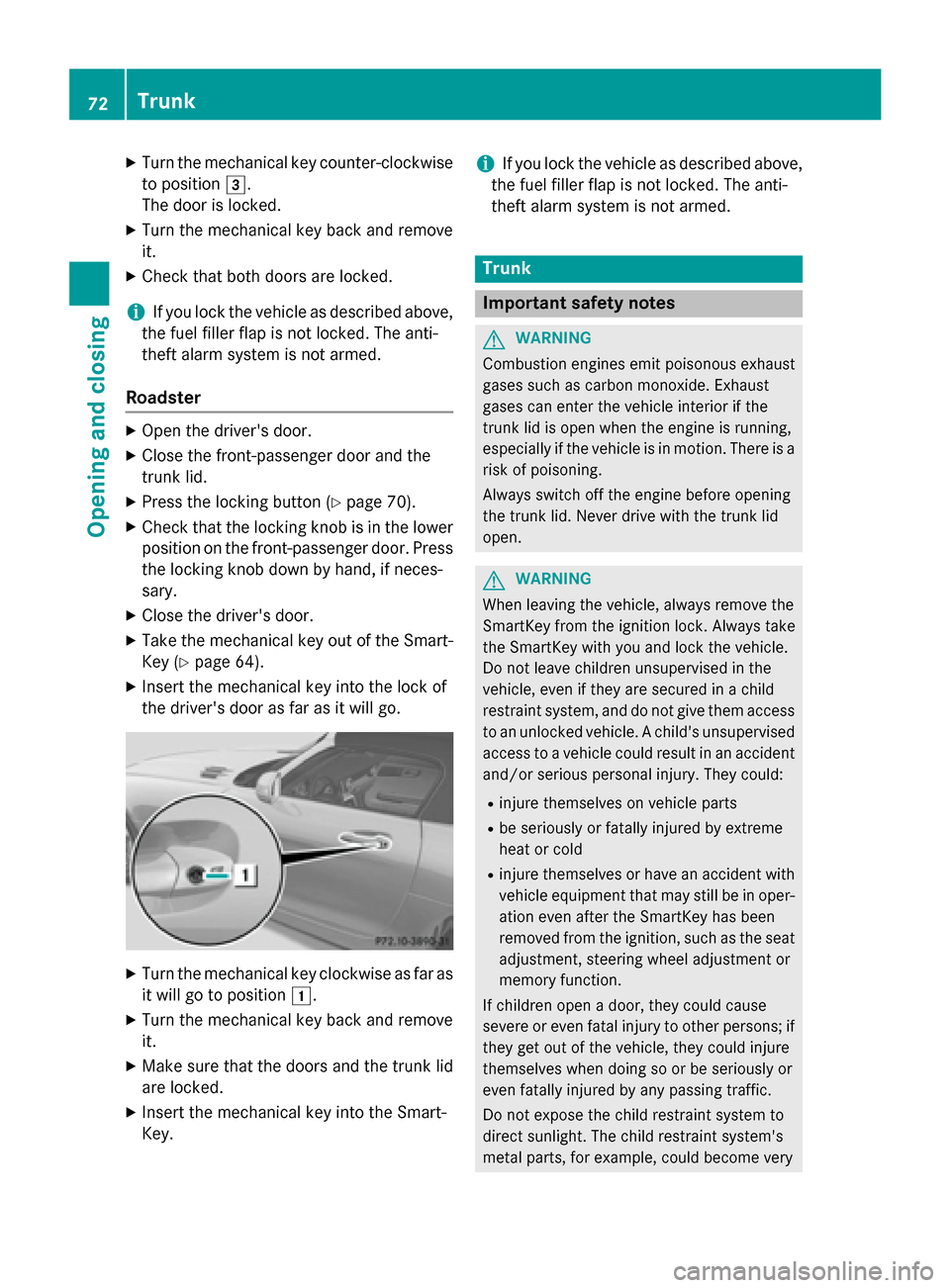
X
Turn the mechanical key counter-clockwise
to position 0049.
The door is locked.
X Turn the mechanical key back and remove
it.
X Check that both doors are locked.
i If you lock the vehicle as described above,
the fuel filler flap is not locked. The anti-
theft alarm system is not armed.
Roadster X
Open the driver's door.
X Close the front-passenger door and the
trunk lid.
X Press the lockin gbutton (Y page 70).
X Check that the lockin gknobisint he lower
position on the front-passenger door. Press the lockin gknobd own by hand, if neces-
sary.
X Close the driver's door.
X Take the mechanical key out of the Smart-
Key (Y page 64).
X Insert the mechanical key into the lock of
the driver's door as far as it will go. X
Turn the mechanical key clockwise as far as
it will go to position 0047.
X Turn the mechanical key back and remove
it.
X Make sure that the doors and the trunk lid
are locked.
X Insert the mechanical key into the Smart-
Key. i
If you lock the vehicle as described above,
the fuel filler flap is not locked. The anti-
theft alarm system is not armed. Trunk
Important safety notes
G
WARNING
Combustion engines emit poisonous exhaust
gases such as carbon monoxide. Exhaust
gases can enter the vehicle interior if the
trunk lid is open when the engine is running,
especially if the vehicle is in motion .There is a
risk of poisoning.
Always switch off the engine before opening
the trunk lid. Never drive with the trunk lid
open. G
WARNING
When leaving the vehicle, alway sremove the
SmartKey from the ignition lock. Always take
the SmartKey with you and lock the vehicle.
Do not leave children unsupervised in the
vehicle, even if they are secured in achild
restraint system, and do not give them access to an unlocked vehicle. Achild's unsupervised
access to avehicle could result in an accident
and/or serious personal injury. They could:
R injure themselves on vehicle parts
R be seriously or fatally injured by extreme
heat or cold
R injure themselves or have an accident with
vehicle equipment that may still be in oper-
ation even after the SmartKey has been
removed from the ignition ,such as the seat
adjustment, steerin gwheel adjustmen tor
memory function.
If children open adoor, they could cause
severe or even fatal injury to other persons; if they get out of the vehicle, they could injure
themselves when doing so or be seriously or
even fatally injured by any passing traffic.
Do not expose the child restraint system to
direct sunlight. The child restraint system's
metal parts, for example, could become very 72
TrunkOpening and closing
Page 85 of 290
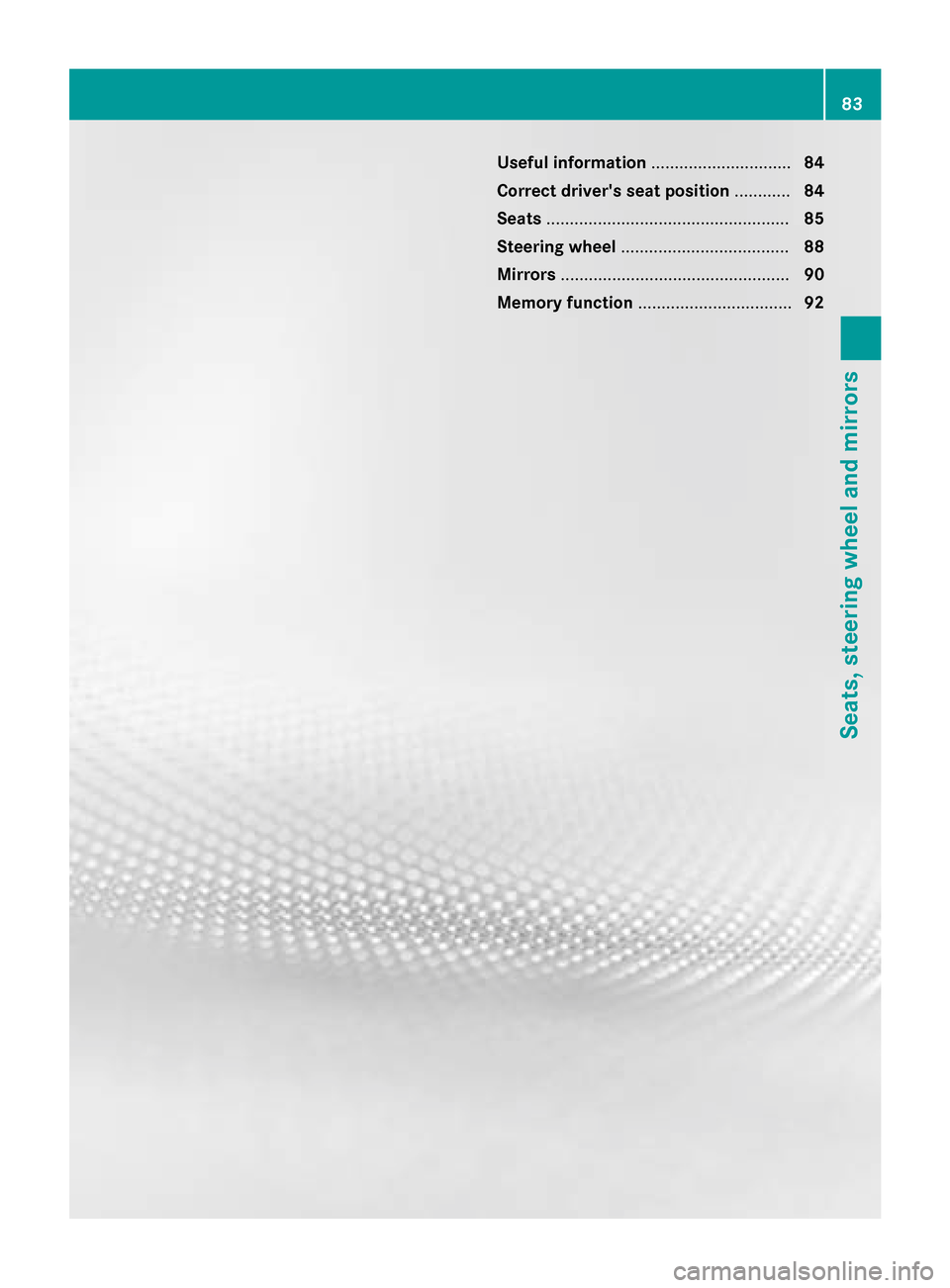
Useful information
..............................84
Correct driver's seat position ............84
Seats .................................................... 85
Steering wheel .................................... 88
Mirrors ................................................. 90
Memor yfunction ................................. 92 83Seats, steering wheel and mirrors
Page 86 of 290
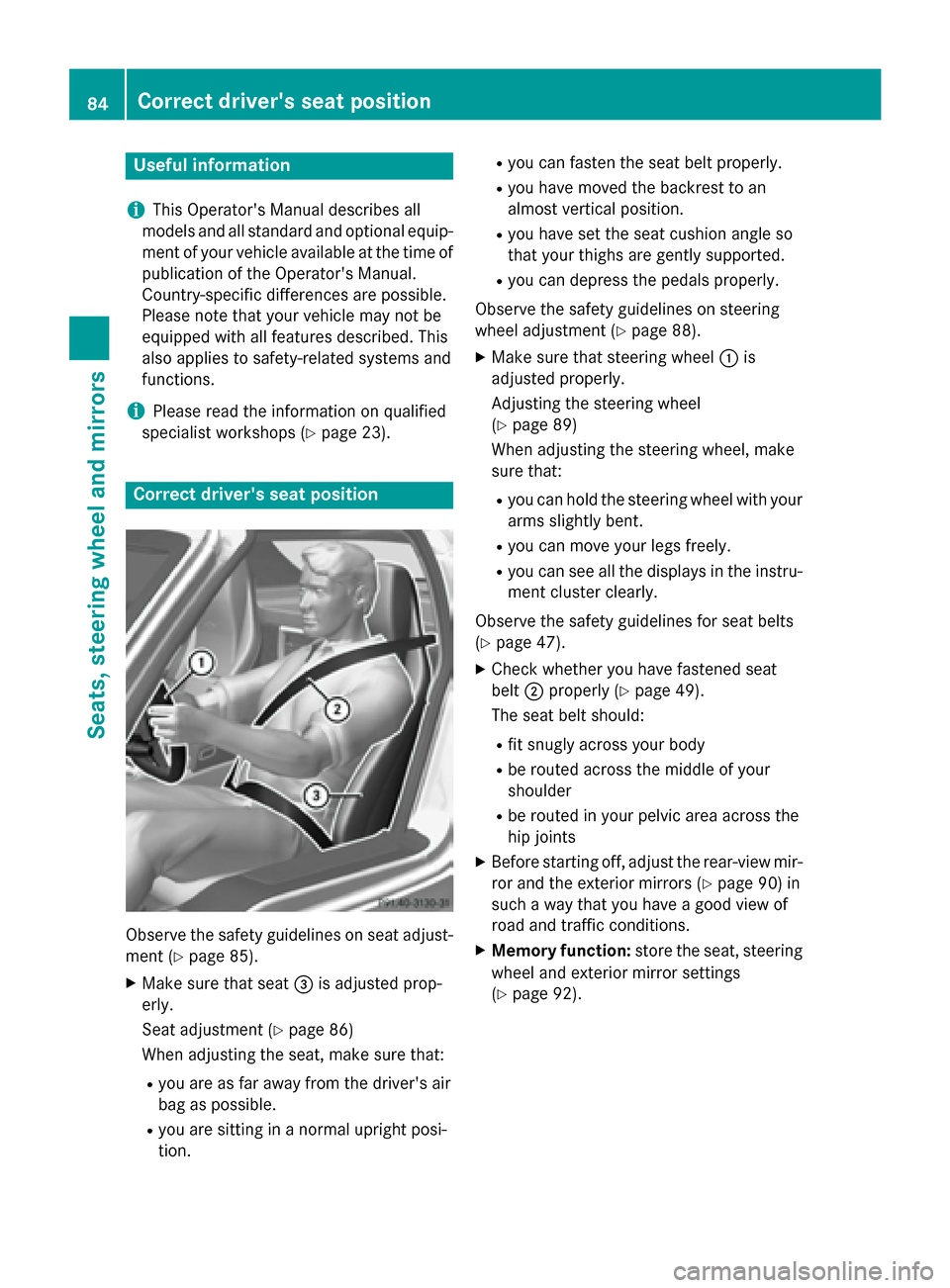
Useful information
i This Operator's Manual describes all
models and all standard and optional equip- ment of your vehicle available at the time of
publication of the Operator's Manual.
Country-specific differences are possible.
Please not ethat your vehicle may not be
equipped with all feature sdescribed. This
also applies to safety-related system sand
functions.
i Please read the information on qualified
specialist workshops (Y page 23).Correct driver's seat position
Observ
ethe safet yguidelines on seat adjust-
ment (Y page 85).
X Make sure that seat 0087is adjusted prop-
erly.
Seat adjustment (Y page 86)
When adjusting the seat, make sure that:
R you are as far away from the driver' sair
bag as possible.
R you are sitting in anormal upright posi-
tion. R
you can faste nthe seat belt properly.
R you have moved the backrest to an
almost vertical position.
R you have set the seat cushion angle so
that your thighs are gently supported.
R you can depress the pedals properly.
Observ ethe safet yguidelines on steering
wheel adjustment (Y page 88).
X Make sure that steering wheel 0043is
adjusted properly.
Adjustin gthe steering wheel
(Y page 89)
When adjusting the steering wheel, make
sure that:
R you can hold the steering wheel with your
arms slightly bent.
R you can move your legs freely.
R you can see all the displays in the instru-
ment cluster clearly.
Observ ethe safet yguidelines for seat belts
(Y page 47).
X Check whether you have fastened seat
belt 0044properly (Y page 49).
The seat belt should:
R fit snugly across your body
R be routed across the middle of your
shoulder
R be routed in your pelvic area across the
hip joints
X Before starting off, adjust the rear-view mir-
ror and the exterior mirrors (Y page 90) in
such away that you have agood view of
road and traffic conditions.
X Memor yfunction: storethe seat, steering
wheel and exterior mirro rsettings
(Y page 92). 84
Correct driver's seat positionSeats, steering wheel and mirrors